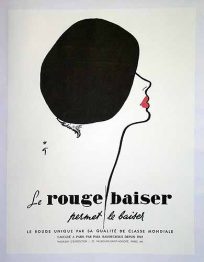This is a fine art lithograph. It’s an original work of fine art which was produced at the prestigious S2 Atelier in New York City in 1998. It was inspired by a poster first created in 1929. These fine art lithographs are recreations of the original. Great care was taken to precisely re-create the artists original image. Most of the chromists hand draw directly onto specially prepared surfaces that are then transferred onto lithographic plates. Lithography involves creating hand drawn plates, one for each color, which are then ‘pulled’ through antique printing presses one color at a time. The resulting lithograph is in pure color, as opposed to the dot structure which occurs in the photographic process of modern printing. At the heart of the S2 Atelier are it’s two rare, French made Marinoni Voirin ‘editioning’ printing presses ‘ they both date back to the mid 19th century. These are the best fine art lithographs made in the industry today. You cannot find anything better than these.Created in 1929 during the peak of his creativity, Cafe Le Martin” is an example of the artist’s skill in lithography as well as clearly demonstrating why he isconsidered a master colorist.Charles Loupot was born in 1892. After being wounded in World War 1, he joined his parents in Geneva and began to work in lithography. His first poster dates back to1917. In 1923, Loupot moved to Paris and was commissioned by “La Gazette Due Bon Ton” and “Femina” based on his experience as a fashion posterist and illustrator. His two posters for Voisin automobiles were immediately successful.He was given the prestigious assignment of designing the poster for the famed 1925 Decorative Arts Exhibition. This important exhibition gave the Art Deco movement itsname and helped it dominate applied arts for the next decade. From 1925 to 1930 he became the art director of “Les Belles Affiches” where he created numerous designs,among them “Le Cafe Martin.”During the period 1930 to 1934, the two greatest advertising artists of the day, Cassandra and Loupot, worked under the name Alliance Graphique. Loupot also continuedto maintain his personal clientele. One of his most important clients was the great industrialist Eugene Schueller, who commissioned posters for products includingMonsavon and Dop shampoo.After World War II, he continued his work for Alliance Graphique and also became the art director for “Les Arcs.”The retrospective exhibition of Charies Loupot’s posters at the Musee de I’Affiche in Paris in 1979, created renewed interest and appreciation of this artist’s work.”
Additional information
| Weight | 0.25 lbs |
|---|---|
| Dimensions | 38.38 × 52.38 × 0.002 in |
Artist: Charles Loupot
Year: 1929
Type: lithograph
Year: 1929
Type: lithograph
Le Caf’ Martin
Out of stock
Out of stock





